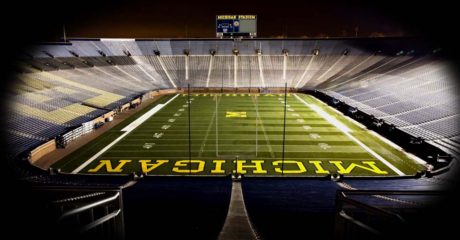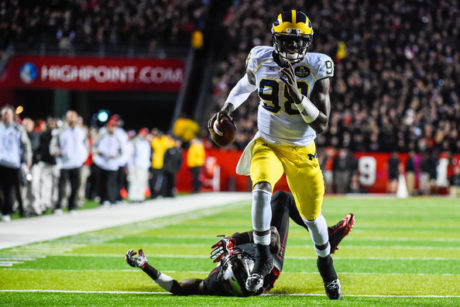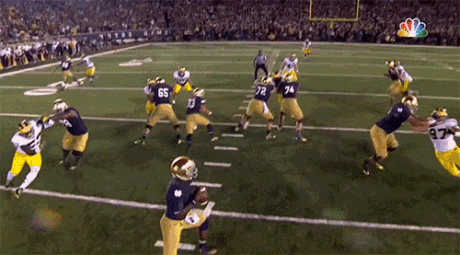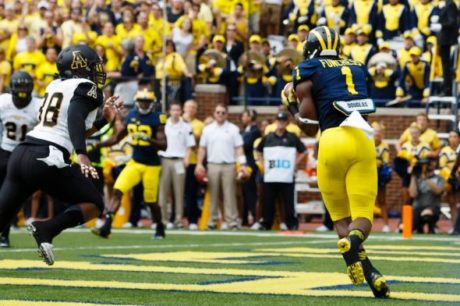Rutgers 26, Michigan 24
 |
| Devin Gardner (image via Zimbio) |
The referees were kind of terrible. The best (or worst) example of this was late in the fourth quarter. Michigan finally used a half-roll – which I’ve been calling for all year – to get quarterback Devin Gardner away from pressure, and he hit Amara Darboh near the sideline. Darboh took two steps with the ball in his possession, turned forward to stretch the ball across the first down marker, dove, lost control of the ball just before he hit the ground, and the pass was called incomplete. A review didn’t come from the booth, so Michigan finally called a timeout. It was challenged, they went back to look at it, and the officials didn’t even say the play “stands” – they said the call was “confirmed.” Add to that a clear pass interference call they missed on a key third down when Jehu Chesson was hip-checked to the ground, plus a non-call against Jake Ryan, and a couple other iffy calls, and the refs were just bad. They were bad both ways, but at the most critical time, on a reviewable play, they botched the call terribly.
Jeremy Clark is not an answer. I’ve been wanting to say this for a few weeks, but for whatever reason, I’ve held off. Clark’s lack of field awareness has hurt Michigan numerous times this season, and this time he cost Michigan an 80-yard touchdown pass. I don’t really understand why the coaching staff makes him the deep safety because he’s not a guy who makes plays in space. I will grant that he has decent speed, but it doesn’t matter much if he’s often out of position. The more experienced player, Jarrod Wilson, should be back there. The plays Clark has made this year have been tackling in the run game and pass coverage in the flats. He has not made a single impressive play from the deep safety position. He takes poor angles, gets caught flat-footed, doesn’t properly recognize route combinations, etc. It’s extremely frustrating that the coaches appear not to have a better answer yet.
The presence of Devin Gardner infuriates me. Granted, he makes at least one bonehead play a week, but he should have been the starter last week against Minnesota in a winnable game. This week’s bad decision was a ball he lofted into the middle of the field with nobody but a Rutgers safety anywhere near the ball, except perhaps Devin Funchess, who was running up the left sideline. Otherwise, Gardner was 13/22 overall for 178 yards. His feet were a huge part of keeping drives alive and scoring touchdowns. The national leaders in sacks got him 3 times for -18 yards, but he ran 7 other times for 58 yards, including 2 touchdowns. He has enough arm strength to make all the throws in college, and he has some chemistry with a few Michigan receivers – Devin Funchess, Jake Butt, Amara Darboh, even Dennis Norfleet. Shane Morris, meanwhile, has yet to throw a touchdown pass and has shown no discernible chemistry with even a single receiver. I’m not saying that Michigan would have beaten the Gophers, but he would have given them a chance.
Don’t let other “analysts” fool you about Gardner’s abilities from under center. I have read numerous times that Gardner should not be taking snaps from under center, that Michigan’s waggle is a disaster waiting to happen, that playing from under center takes away his running ability, etc. All of that is bull. First of all, this is Doug Nussmeier’s offense. Just like Rich Rodriguez could not be expected to run a pro-style offense, we shouldn’t expect Nussmeier to run a shotgun-only offense with all kinds of power reads, inside zone reads, midline reads, etc. Second, Gardner on a waggle or bootleg generally puts him in space with a player who is physically overmatched. I don’t see how people watch things like Gardner’s two touchdown runs in this game, and then walk away concluding that Gardner can’t use his legs in this offense. People who say stuff like that are enamored with shotgun spread offenses, and in my opinion, their comments are being colored by an agenda rather than football knowledge.
Stop holding. I mean, come on, guys. Is this so difficult? Michigan took two holding penalties – by Mason Cole and Kyle Kalis – that put them behind the sticks. Why did they have to hold? They stopped moving their feet. If they keep moving their feet and working their hips around to the playside, then they wouldn’t have to grab jersey. The holding call on Kalis was especially egregious on his part. I would think the son of an NFL lineman would know better by now. I don’t know if it’s coaching, stupidity, laziness, or a combination of all those things. There aren’t many teams who can overcome 1st-and-20 or 2nd-and-20.
Has Michigan found a running game? It seemed like things started clicking in the fourth quarter, or maybe it was just Rutgers getting worn down. Either way, the Wolverines started having some consistent success in the running game, especially over the left side. Last week Derrick Green had a poor game, while De’Veon Smith had one good drive. This week it was Green’s turn. He carried 12 times for 74 yards (6.2 yards/carry), and while he left some yards on the field by getting ankle-tackled, it was a solid night for him overall. Michigan actually out-rushed Rutgers by a wide margin (158 to 74).
Play action passing game improvements. Michigan had some success with inside zone runs out of the shotgun, and that helped set up some play action. It seems like Michigan has honed its backfield action to include a more believable mesh between quarterback and running back. I think that paid some dividends tonight, and it should going forward as well. That’s a small detail, but I think it indicates some growth in the offense. Rutgers doesn’t have a great defense, but Michigan looked better than they did against Notre Dame, Utah, or Minnesota. I still have faith in offensive coordinator Doug Nussmeier that he can improve this offense. Unfortunately, it appears he may not get a chance to see it all the way through with Brady Hoke likely getting fired by/at the end of the season.
Why was Rutgers able to pass the ball so well? Most importantly to answer this question, Michigan does not have a consistent pass rush. A few times on the evening, they quickly got in the backfield – a Frank Clark rush from middle linebacker, a Willie Henry dismantling of the offensive line, a TE stunt by Taco Charlton, etc. The problem is that when Michigan didn’t slice cleanly through the offensive line, they couldn’t disengage quickly enough to put pressure on Rutgers quarterback Gary Nova. It’s all or nothing. Meanwhile, Jeremy Clark is unfit to play his position, Delano Hill has been injured most of the season, and Jabrill Peppers has mostly been sidelined for one reason or another. Michigan is missing two of its five starters in the defensive backfield (Peppers, Hill), a third starter is very weak (Clark), and a lack of a pass rush hurts. You also have to tip your hat to Nova and company, who made some nice plays on the evening.
Can Michigan beat anyone left on the schedule? Yes. Penn State, Northwestern, and Maryland are all possibilities. I think Michigan State, Ohio State, and Indiana are all looking very unlikely. It’s obviously a steep uphill climb to reach bowl eligibility at 2-4.








